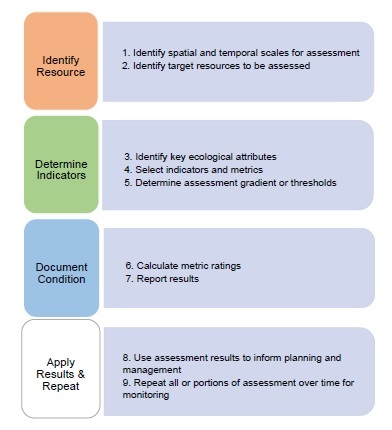Introduction
Assessing the ecological condition of ecosystems is a key aspect of land and water management. Natural resource managers need to assess the condition of grasslands, streams, riparian areas, forests, and shorelines, and then use those results to determine if there is a need for change in management. They can then describe desired conditions and land management outputs, reconciling needs for military training. These conditions and outputs could address issues such as maintenance of riparian zones, provision of wildlife habitat, or location, type, and intensity of military use.
Like other land managers, the DoD seeks to manage lands in a manner consistent with maintaining or making progress toward achieving the fundamentals of land health; namely: (1) properly functioning physical condition of watersheds, (2) ecological processes such as hydrologic and nutrient cycling that support healthy biotic populations and communities, (3) water quality that complies with State standards and achieves agency objectives, such as meeting wildlife needs, and (4) restoration or maintenance of habitat for Federal threatened and endangered species, Federally proposed or candidate species, and other special status species. Natural resource evaluations can establish the degree to which these standards are being achieved by measuring specific ecological condition indicators relevant to each standard.
Management questions and ecosystem condition
Typically, resource management questions address some aspect of ecosystem composition, structure or function, and ecological condition assessments are designed to help answer those questions. Condition assessments result in outputs that allow military land managers to address questions such as “What are appropriate intensities of vehicle access in each management compartment? Where should we target specific types of training exercises to be compatible with maintaining wildlife habitat? What are the major stressors that need to be reduced to improve riparian functions?”
Managers also have a range of spatial scales and timeframes in which to express management questions. At the local scale, a manager may want to assess land health as part of the process of updating allowable training uses within each management compartment. Primary concerns may focus on the degree of soil compaction, local invasive plant abundance, or trends in native plant diversity, stream bank erosion, and overall biomass productivity. At the level of the installation, the need may be to report on trends in overall condition of riparian zones or grasslands relative to management or policy goals. Answers to these questions then inform resource allocation decisions associated with multiple-use management for protection of sensitive cultural resources, risk reduction from wildfire, addressing effects of altered natural disturbance regimes and invasive species, or restoring natural habitat for species of concern.
A framework for assessing ecological integrity
While there are several assessment approaches used by natural resource managers to address a range of needs, one increasingly common approach to assessing ecological condition is through measures of ecological integrity (Harwell, et al. 1999, Andreassen et al. 2001, Young and Sanzone (2002), Parrish et al. 2003, Faber-Langendoen et al. 2016, Unnasch et al. 2018). For example, the Bureau of Land Management defines ecological integrity as “the ability of ecological systems to support and maintain a community of organisms that have the species composition, diversity, and functional organization comparable to those of natural habitats within the ecoregion range or area” (from Karr and Dudley 1981). This definition embodies three components of ecosystems: composition, structure, and function. Measures of ecological integrity are now in wide use for planning, management, and monitoring purposes across multiple agencies and organizations (see examples in Carter et al. 2016, Wurtzebach and Schultz 2016, Unnasch et al. 2018). But as Pellant et al. (2018) noted, the challenge to scientists and managers is to translate this concept into terms that natural resource managers can use to assist in identifying areas where ecological processes are or are not functioning properly. Here we show how a stepwise procedure for ecological integrity assessment can help meet that challenge.
Stepwise procedure for ecological integrity assessment
This stepwise procedure supports assessment, planning, management, and ongoing monitoring of natural resources, and provides a basis for enhancing ecological resilience in the face of multiple kinds of stressors.
Specifically, the framework guides assessment of resource condition through three major steps:
• Identify the Important Resources: Determine the suite of biological and ecological resources that need to be managed. This step includes identifying the geographic (spatial) and temporal scope of the planning effort; identifying the suite of natural resources of potential concern; identifying stressors known, suspected, or anticipated to affect these resources; and selecting a subset of the unit’s ecological resources on which to focus management (we’ll use the term “target resources”).
• Determine Indicators of Condition: Develop metrics to assess the integrity of the target resources. This step includes documenting the ecology of each target resource and identifying the key ecological attributes for each; identifying indicators for these key attributes and an ecologically expected range of variation for each indicator.
• Document the Condition of the Resources: Apply measures to determine the current integrity of the target resources. This step includes measuring indicators and determining the status of each target resource based on indicator data.
The three major steps of the framework can be detailed into 7 specific steps (Figure 8.4). In steps 1-2, the assessment effort is defined in terms of the overall area, component assessment zones or reporting areas, relevant timeframes, and target resources (e.g., ecosystem types) to be assessed.
In steps 3–5, the information is organized using conceptual models to summarize drivers and stressors, and the key ecological attributes that determine their integrity. The information guides the selection of suitable indicators and metrics to assess those key attributes. In steps 6–7, measures are gathered, synthesized, and reported. Once the assessment is complete, reported results may be applied directly to stating desired conditions for vegetation management and/or be repeated periodically within a systematic monitoring plan to track ongoing management activities. Each of these specific steps of the framework is described in detail in what follows.

Next Page: Identify the resources
Author
Patrick Comer, Ph.D., Chief Ecologist
NatureServe
